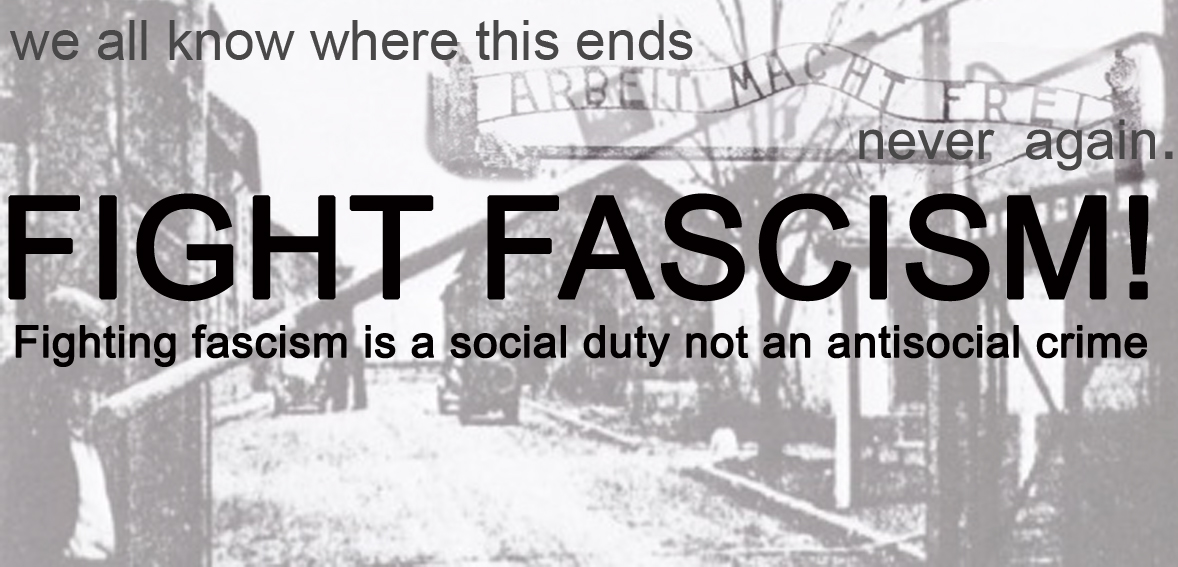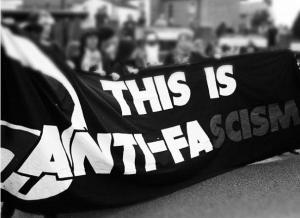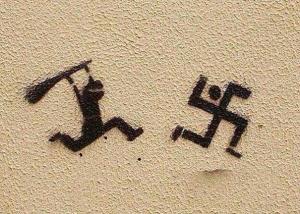We see clearly the “special relationship” between fascism and democracy.
The two are co-dependent and complement each other well. As much as politicians
decry the “hate filled extremism” of fascism and however much they try to distance
themselves from right wing fundamentalism, they will always use it for their own
ends, either indirectly or directly. This is most obvious in situations of
political, social or economic crisis and conflict such as what we see in Greece and
the Ukraine. There we have seen open collusion between fascists and the authorities,
and murderous attacks on demonstrations, political opponents and immigrants, as the
fascists once again step up to their long established role as paramilitary enforcers
of the state.
Time and time again history has shown that their democracy is a carefully
manufactured illusion and a diversion. Capitalism and it’s governmental protectors
will always unleash the forces of reaction when under serious pressure. Governments
and capitalists everywhere, when it comes to it, will always choose fascism against
progressive or revolutionary social movements. Both use fear and violence to gain or
maintain power and control. The only difference is in the words employed: “security”
from the government alongside the “violence” of the fascists. Both rely on divisive
strategies to get what they want: “immigration policies” of the state alongside the
“racism” of the far right. Attacks on the working class is another shared and core
basic principle and preoccupation of fascism and government alike. With so much in
common the only real differences are ones of scale and success. Clearly the everyday
violence, racism and relentless attacks of governments everywhere are streets ahead
and so much more effective and far reaching than your average fascist party or
group.
Politicians and fascists alike do the bidding of the rich and stand in
the way of real change and the struggle for a better world. Both are the enemies of
freedom and it is time we started treating them as such.

The elections of last week saw a surge in popularity for foreigner-bashing, Tory jackbootboys, UKIP, who gained 161 councillors in England and topped European election polls with 27% of the vote (with a voter turn out of 34%). The rest of Britain’s far-right, however, saw its vote collapse at the elections. The BNP, which has recently been seen as the most serious far-right political threat, saw losses in support across the country retaining only one council seat and coming out with no MEPs, two less than in 2009.
Below are the election results for councils in England & NI. More analysis on Anti-Fascist Network blog.
BNP
East Midlands
Amber Valley
Codnor & Waingroves – Alan Edwards 39 2.7%
Ripley – Ken Cooper 80 3.2%
Derby
Chaddesden – Paul Hilliard 136 4%
Derwent – Carol Tucker 81 3.4%
London
Barking and Dagenham
Eastbrook – Anthony McKay 222 3%
Eastbrook – Paul Sturdy 166 2.2%
Goresbrook – Bob Taylor 469 7.1%
Mayesbrook – Giuseppe De Santis 280 5%
Bexley
Barneshurst – Paul Hulme 89 1%
Belvedere – Brian Haslam 328 4%
Blackfen & Lamorbey – Chris Wait 287 3%
Blendon & Penhill – Erin Bradley 390 4%
Brampton – Maureen Slaughter 268 3%
Christchurch – Ben Scott 241 3%
Colyers – Peter Finch 383 5%
Cray Meadows – John Brooks 262 3%
Crayford – Stephen James 539 6%
Danson Park – Ronald Slaughter 295 4%
East Wickham – Michael Jones 381 4%
East Wickham – Nicola Finch 346 4%
East Wickham – Jaymie McCoy 216 2%
Erith – Robert Howard 323 4%
Falconwood & Welling – Jimmy Dobson 398 4%
Lesnes Abbey – Carl Bussey 284 3%
North End – Mark Horne 407 6%
Northumberland Heath – Paul Carver 444 5%
Sidcup – Lucy Ann Money 181 2%
St Mary’s – Mark Bryant 271 3%
St Michael’s – Laurence Picton 407 5%
Bromley
Cray Valley East – Deborah Kane 284 7.2%
Cray Valley West – Roger Tonks 139 3.3%
Mottingham & Chislehurst North – Philip Dalton 181 6.8%
Croydon
Fieldway – David Clarke 210 4.8%
Fieldway – John Clarke 212 4.8%
Heathfield – Michael Collard 285 2.5%
New Addington – Cliff Le May 168 3.1%
New Addington – Donna Treanor 80 1.4%
Ealing
Northolt Mandeville – David Smith 234 2.4%
Northolt West End – David Furness 362 3.4%
Enfield
Enfield Highway – Gary O’Connor 289 3%
Enfield Lock – Jason Keogh 296 3%
Palmers Green – Angelos Gavriel 158 4%
Ponders End – William Walton 223 2%
Southbury – Marie Nicholas 223 2%
Turkey Street – Steve Squire 278 3%
Greenwich
Coldharbour & New Eltham – Cliff Adams 401 3.8%
Eltham North – Roberta Woods 307 2.3%
Eltham South – Thelma Peete 248 2.5%
Eltham West – Paul Ramsey 314 4.8%
Middle Park & Sutcliffe – Nick Scanlon 313 3%
Havering
Gooshays – Ray Underwood 247 2.3%
Heaton – Kevin Layzell 556 6.1%
Hillingdon
Yiewsley – Vincent Evans 304 3.7%
South Ruislip – Gavin Cardy 223 2.5%
Kingston-upon-Thames
St James – David Child 100 1%
North West
Bolton
Tonge with The Haulgh – Dorothee Sayers 109 3.3%
Burnley
Gannow – John Rowe 149 4.8%
Rosegrove with Lowerhouse – Chris Vanns 297 21.9%
Manchester
Miles Platting & Newton Heath – Gareth Black 397 14.2%
Moston – Stephen Carden 153 4.2%
Pendle
Marsden – Brian Parker 339 29.8%
Vivary Bridge – John Rowe 154 11.4%
Salford
Cadishead – Brenda Leather 397 16.1%
Irwell Riverside – Gary Tumulty 73 3.4%
Langworthy – Kay Pollitt 86 3.4%
Pendlebury – Eddy O’Sullivan 122 4.4%
Winton – Wayne Tomlinson 323 12.3%
St Helens
Billinge & Seneley Green – Alan Brindle 64 1.2%
Thatto Heath – Paul Telford 51 2%
Town Centre – Peter Clayton 87 3.5%
Stockport
Bredbury & Woodley – Andy Webster 89 2%
Bredbury Green & Romiley – Tony Green 60 1%
Brinnington & Central – Brenda Waterhouse 93 3%
Heatons South – Sheila Spink 165 4%
Manor – Duncan Warner 67 2%
Reddish North – Paul Bennett 419 13%
Reddish South – Ged Williams 271 8%
Tameside
Ashton St Peter’s – Bill Kitchen 303 10.3%
Droylsden West – Ian Connor 106 3.4%
Wigan
Abram – Dennis Shambley 134 4.8%
South West
Exeter
Priory – Chris Stone 38 1.4%
West Midlands
Birmingham
Erdington – Frances Waldron 703 1.2%
Kingstanding – Frances Burke 92 2.1%
Shard End – Kevin McHugh 134 2.9%
Coventry
Bablake – Mark Badrick 74 1.7%
Binley & Willenhall – David Clarke 108 3%
Cheylesmore – Stephen Comer 327 7.7%
Henley – Rose Morris 109 3%
Holbrook – Christine Wilkins 292 8.1%
Longford – Frankie Bates 78 2%
Lower Stoke – Keith Oxford 70 1.76%
Radford – Arnold Clements 372 11.1%
Sherbourne – Mark Graham 73 2%
Upper Stoke – John Hurren 94 2.4%
Westwood – Darren Thomas 348 8.8%
Whoberley – Dawn Wagstaff 54 1.3%
Woodlands – Hunter Helmsley 69 1.6%
Dudley
Coseley East – Ken Griffiths 123 3.9%
Nuneaton & Bedworth
Arbury – Phillip Kimberley 48 2.9%
Barpool – Alwyn Deacon 71 4.4%
Bede – Yvonne Deacon 206 12.5%
Walsall
Birchills-Leamore – Bob Ball 140 4.8%
Wolverhampton
Bushbury North – Simon Patten 116 3.7%
Worcester
Battenhall – Jennifer Whitwam 16 0.8%
Bedwardine – Timothy Whitwam 37 1.5%
Cathedral – Andrew North 24 0.8%
Gorse Hill – Ashley Bradley 31 2.7%
Nunnery – Carl Mason 286 13%
Rainbow Hill – Alan Draper 36 2.8%
St John – Linda Bell 30 1%
Warndon – Julie Whitwam 32 2.9%
Northern Ireland
Mid & East Antrim
Coast Road – Robert Bell 101 1.8%
Coast Road – Steven Moore 73 1.3%
National Front (Ian Edward’s faction)
Basildon
Laindon Park – Anthony Harms 21 1%
Lee Chapel North – Thomas Beaney 80 2%
Hillingdon
Harefield – Ian Edward 198 4.8%
Southend
Victoria – Bernadette Jaggers 18 1.3%
Thurrock
Grays Thurrock – Thomas Davis 51 2.2%
Tilbury Riverside & Thurrock Park – Mick Griffin 59 4.5%
National Front (Kevin Bryan’s faction)
Croydon
Croham – Tony Martin
Lewisham
Downham – Tess Culnane
Sutton
Worcester Park – Richard Edmonds 185 1.8%
British Democratic Party
Bradford
Royds – Dr Jim Lewthwaite 152 4.5%
Tong – Liam Kernaghan 115 4.2%
Leeds
Middleton Park – Kevin Meeson 358 6.9%
Newcastle
Benwell & Scotswood – Ken Booth 136 4.8%
Elswick – Kenny Baldwin 414 18.5%
Fenham – Russ Rickerby 121 4.3%
Redbridge
Hainault – Julian Leppert 284 3%
Bexley Independents
Bexley
Blackfen & Lamorbey – Michael Barnbrook 884 10%
Other Independents
Bradford
Queensbury – Paul Cromie 1377 35.8%


